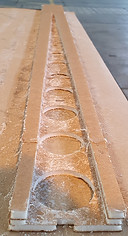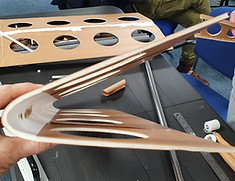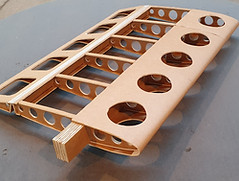GIANT FOAMBOARD AIRCRAFT PROJECT


Foam Board Manufacturing Methods
Butt joint
The butt joint is when 2 pieces of foamboard are glued to one another in a simple perpendicular fashion. The rib in figure 11 joins the pieces around through butt joints. The important part of the butt joint is to the weld along the edges with hot glue. This is done as most of the strength of foamboard come from the paper. Gluing just the foam to the next part will not create a strong bond.
Bend Joint
The bend joint involves bending and glueing the piece of foamboard around the surface of another piece. The piece being bent should be processed by removing the interior paper where the most significant bending will take place and using a heat gun too soften the area for bending. Before application to the assembily, the piece should be bent around another object to test and prepare the piece. This is commonly done on the leading edge pieces of the aerostructre and can be seen below. Glue is applied to the joining surfaces in the same fashion as a butt joint.
Overlap Joint
The overlap joint is used primaraly to joint lengths of foamboard to create a longer part. This is done by removing the foam core and using the excess paper to transfer the load from one piece to another. An example of a wing spar panel can be seen below. This joint creates an area that is stronger then the plain foamboard. This is useful for highly loaded parts where the joint would be an expected point of faliure.
Flat Joint
The flat joint involves gluing 2 flat surfaces areas together using spray adhesive, as seen below. This is used primarily to create pieces of greater thickness for structural strength. The main example of this is in the wing and tail spars. This joint is often a team effort requiring coordination between workers to set the pieces in place. The spray adhesive used is often instant stick so only one chance is available to line up the joint correctly.
Corner Joint
The corner joint is done by cutting through half the thickness along the length of the foamboard and crushing down the length using a roller tool to crush the foam to form a gap. This gap can then be bent and glued to a desiged angle. This can be repeated to form a closed shape which forms a rigid bar, as seen below. This process is used to create structural tubes and for the contol surfaces.







Perrin Tube Instructions
The Perrin tube was developed at the very start of the project and was designed to be a structural member to take axial and bending loads. It is a simple 40x40mm square tube. Constructed by folding and glueing the foamboard along four corners. For the first GFA the entire fuselage was constructed using about 100 tubes. To save time a blank sheet was laser cut with the folds pre-cut onto the surface. The basic instructions can be seen below.

